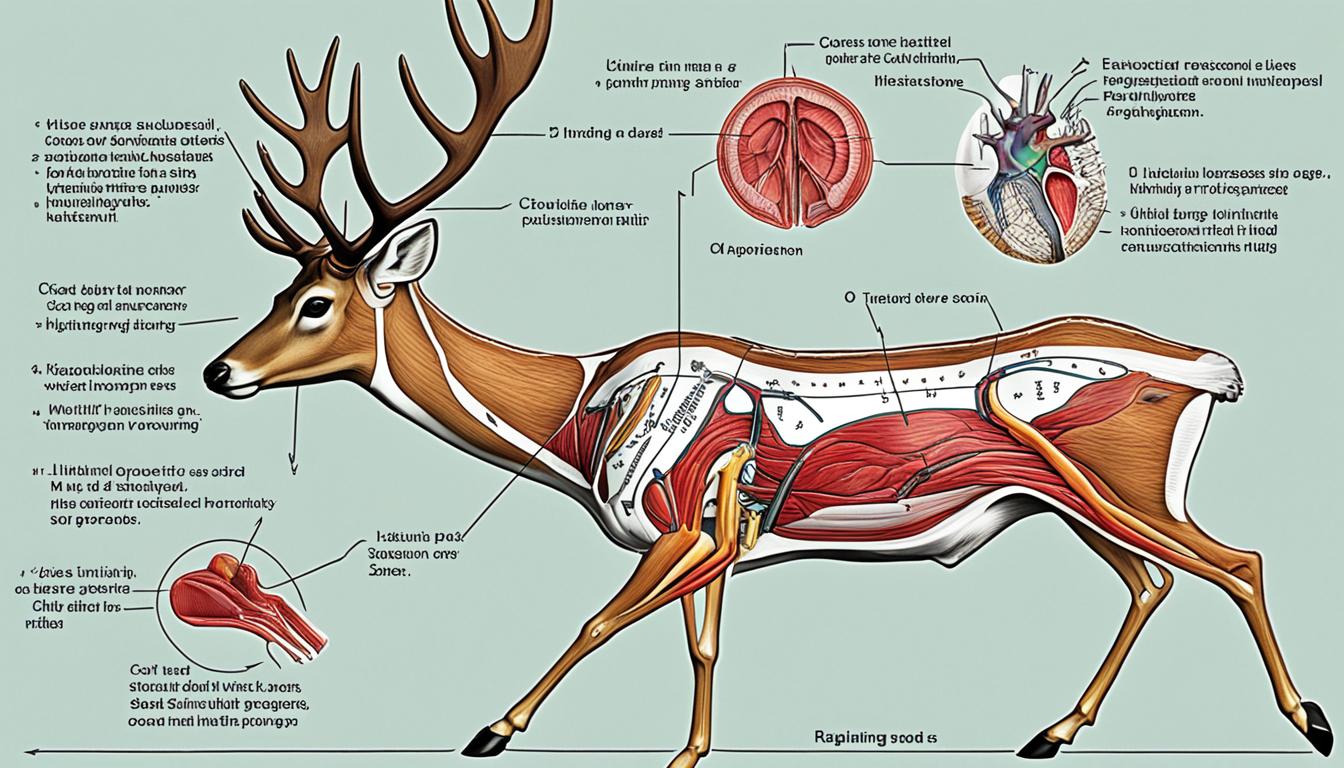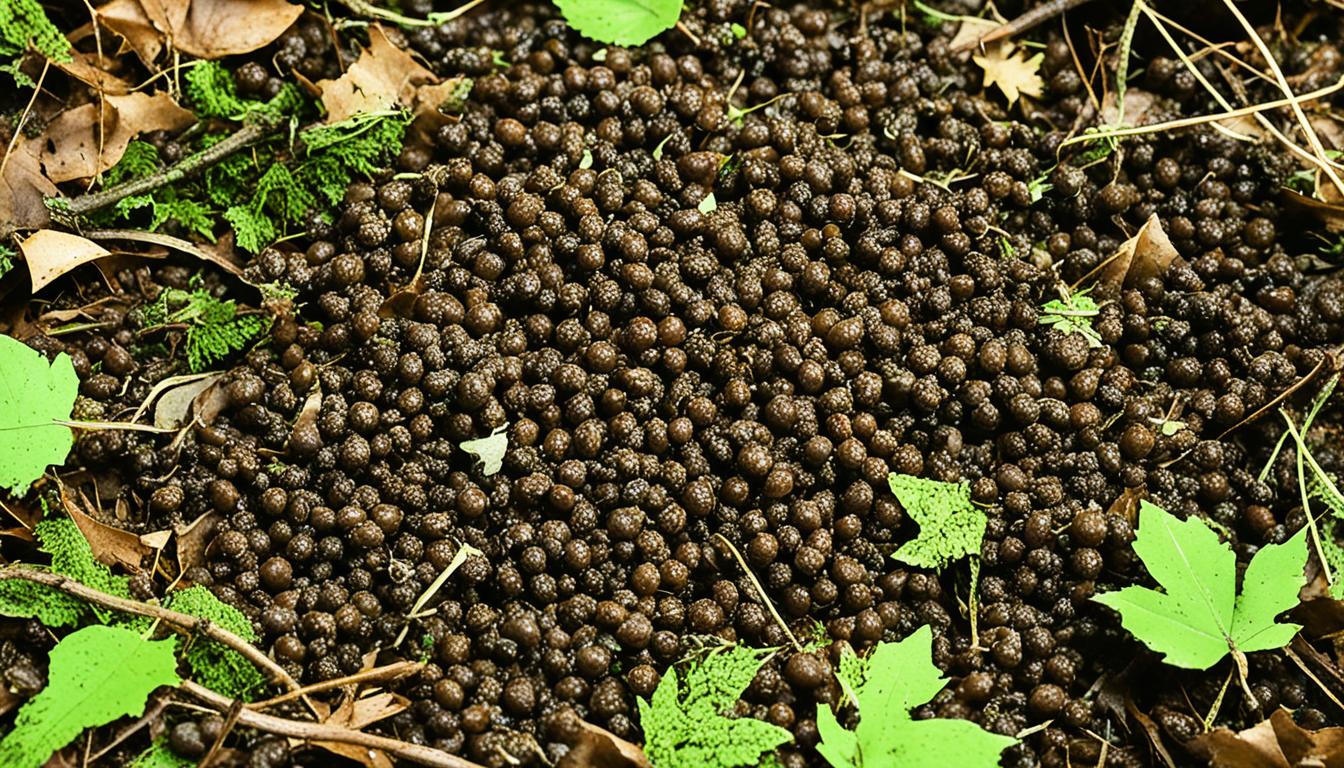Every hunter knows that shot placement is key for a successful and ethical deer harvest. Having knowledge of deer anatomy and understanding where to aim from different angles can greatly improve your chances of a clean, ethical kill. Surprisingly, over 50% of hunters wound deer without recovering them due to inaccurate shot placement. This alarming fact underscores the significance of mastering shot placement techniques to guarantee a humane and responsible hunt. This detailed guide will explore the essential organs of a deer, the optimal shot placements for different angles, and the significance of precision in hunting.
Key Takeaways:
- Shot placement is essential for a successful and ethical deer harvest.
- Poor shot placement can result in wounding and lost deer.
- Understanding deer anatomy is crucial for accurate shot placement.
- The heart and lungs are the primary targets for a swift and clean kill.
- Mastering shot placement techniques ensures a responsible and humane hunt.
Deer Anatomy 101
To improve shot placement, it’s essential to have a good understanding of deer anatomy. The vital organs, such as the heart, lungs, and liver, are prime targets for ethical kills. The lungs, located behind the front shoulder, offer a larger target with a higher margin of error. The heart, partially covered by the lungs, is a smaller but equally important target. The liver, hidden behind the diaphragm, is smaller and more challenging to hit. By knowing the location of these vital organs and understanding the deer’s physical structure, you can make more accurate shots from any angle.
| Vital Organs | Location | Shot Difficulty |
|---|---|---|
| Lungs | Behind the front shoulder | Relatively easier |
| Heart | Partially covered by the lungs | Requires precision |
| Liver | Behind the diaphragm | More challenging |
Deer Vital Organs: Heart and Lungs
When it comes to deer hunting, targeting the heart and lungs is crucial for a quick and humane kill. A well-placed shot to the lungs results in rapid blood loss and organ failure, ensuring a swift and clean takedown. This shot placement technique is highly effective and forgiving, making it an excellent choice for less experienced hunters seeking a quick kill.
Another vital organ to target is the heart. While hitting the heart requires more precision and skill due to its smaller size and the potential movement of the deer, it can result in an equally swift and ethical kill. A heart shot also leads to rapid blood loss and organ failure, incapacitating the deer swiftly.
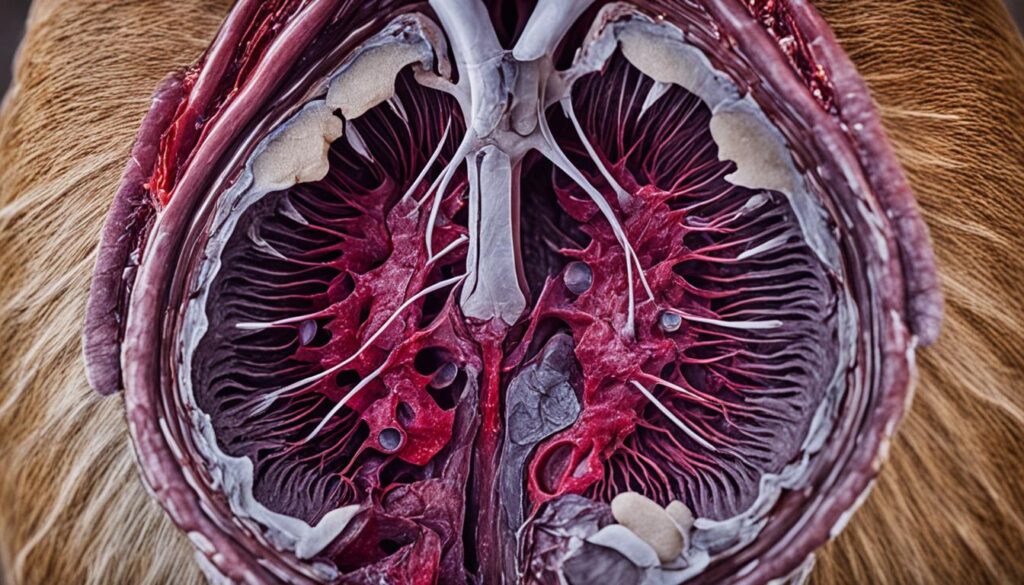
Both the lung shot and heart shot are reliable choices for ethical hunting, but they require different levels of accuracy. The lung shot provides a larger target area and allows for a higher margin of error, making it an ideal option for hunters who may not have mastered extreme precision. On the other hand, the heart shot demands more skill and control due to its smaller size and the need to compensate for potential deer movement.
Choosing between a lung shot and a heart shot depends on a hunter’s skill level and the specific circumstances of the shot. It’s essential to consider factors such as the distance, angle, and the deer’s behavior before deciding which target to aim for. Regardless of the chosen shot, hitting either the heart or lungs will result in a quick and ethical kill, minimizing suffering for the animal.
Tissue, Muscle, and Bones in the Deer’s Body
Deer possess a formidable defense system composed of muscles, bones, and tissue that serve to protect their vital organs. Understanding the anatomy of these organs and the tough structures surrounding them is essential for achieving successful shot placement during hunting.
Protective Shoulders and Scapula
The shoulder and scapula play a crucial role in providing power for a deer’s movement. However, their positioning also makes them challenging targets. Achieving precise shot placement in this area demands skill and accuracy to avoid wounding the animal instead of making a clean kill.
The High-Stakes Shot: The Spine
The spine presents hunters with a high-risk, high-reward shot opportunity. A well-placed shot targeting the spine offers an instant takedown, rendering the deer immobile. However, due to the small target area and the potential for erratic movement, tremendous accuracy is required to make this shot a success.
Targeting the Rib Cage: The Kill Zone
The rib cage, encompassing the heart and lungs, is considered the optimal kill zone. Understanding the position of the rib cage provides hunters with a clear target area for achieving a clean kill. Precise shot placement within this region ensures swift organ damage, leading to a quick and ethical takedown with minimal suffering.
| Target Area | Importance |
|---|---|
| Rib Cage | The sweet spot for a clean kill, housing the vital heart and lungs. |
| Shoulder and Scapula | Challenging targets that require precision shooting skills. |
| Spine | A high-stakes shot offering an instant takedown but demanding unparalleled accuracy. |
Understanding the structural barriers protecting the vital organs is essential for successful shot placement during deer hunting. By being knowledgeable about the shoulder and scapula, spine, rib cage, and the corresponding kill zones, hunters can enhance their accuracy and increase the probability of a swift and ethical kill.
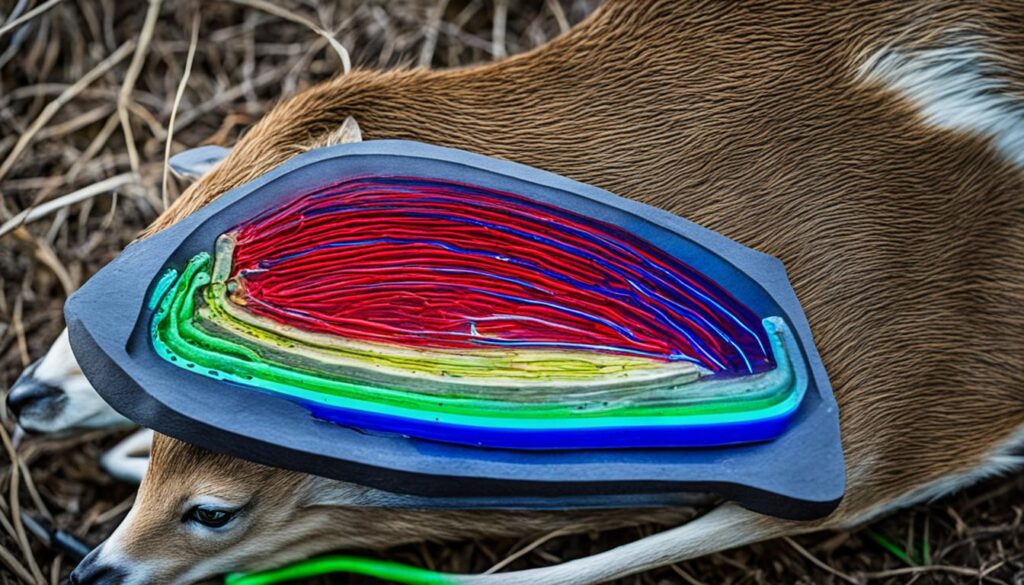
What’s the Best Shot Placement on Deer?
The best shot placement on a deer is targeting the lungs. Due to their larger size and proximity to the heart, the lungs offer the most substantial kill zone and safety net. A clean shot to this area causes rapid blood loss and organ failure, resulting in a quick and efficient kill. While hitting the heart and lungs is a deadly combination, it requires more precision. The lungs remain the optimal target for a clean and ethical takedown.
When hunting deer, understanding the best shot placement is vital for achieving a quick and ethical kill. By focusing on the lungs, hunters can increase their chances of success while minimizing unnecessary suffering for the animal.
“Targeting the lungs provides a larger margin of error and ensures a humane, ethical kill,” says seasoned hunter and wildlife expert, John Anderson. “Hitting this vital organ leads to rapid blood loss and subsequent organ failure, resulting in a clean and effective takedown.”
While the heart and lungs present a deadly combination, it’s important to note that hitting the heart requires more precision due to its smaller size and potential movement of the deer. The lungs, on the other hand, offer a larger target area, increasing the chances of a successful shot. For hunters, the lungs remain the optimal kill zone.
To illustrate the effectiveness of targeting the lungs, let’s take a closer look at the anatomy of a deer:
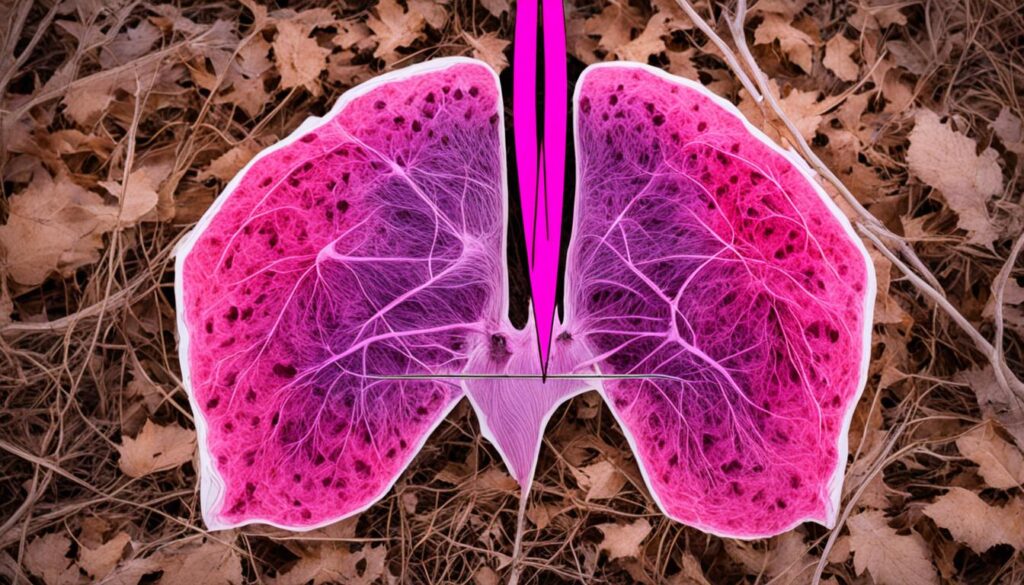
| Vital Organs | Location | Target Characteristics |
|---|---|---|
| Lungs | Behind the front shoulder | – Larger target – Higher margin of error |
| Heart | Partially covered by the lungs | – Smaller target – Higher precision required |
| Liver | Hidden behind the diaphragm | – Smaller target – More challenging to hit |
As shown in the table above, the lungs are easily accessible behind the front shoulder, providing a larger target area and a higher margin of error. This makes them the ideal kill zone for ethical hunters.
By focusing on effectively targeting the lungs, hunters can achieve quick and clean kills, ensuring a more responsible approach to hunting and conservation.
Deer Shot Placement Guide Based on Hunter Angles
The angle and distance between the hunter and the deer play a critical role in shot placement. Understanding the different angles and their implications can help hunters make informed decisions for successful and ethical kills.
Broadside Shot
The broadside shot occurs when the deer is perpendicular to the hunter. This angle provides the best opportunity to hit the vital organs, including the heart and lungs, with a broad target area. It offers a high chance of quick and effective kills.
Quartering-Away Shot
The quartering-away shot is when the deer’s body is angled away from the hunter. While not as ideal as the broadside shot, it still allows access to the heart and lungs. Hunters must aim behind the shoulder, towards the midsection of the deer, to achieve optimum shot placement and a clean kill.
“The broadside shot provides the best opportunity to hit the vital organs, while the quartering-away shot can still offer a good chance for an ethical kill.”
Quartering-Towards Shot
The quartering-towards shot presents a more challenging scenario. This angle carries a higher risk of hitting the front shoulder and guts instead of the vital organs. It is not recommended unless the hunter is experienced and confident in their accuracy. In such cases, one must aim towards the front part of the deer, just behind the shoulder, to avoid hitting non-vital areas.
To summarize, understanding the broadside, quartering-away, and quartering-towards shots is crucial for hunters to make accurate and ethical shot placements. The broadside shot offers the best opportunity to hit the vital organs, while caution must be exercised with the quartering-away and quartering-towards shots to avoid potential damage to non-vital areas.
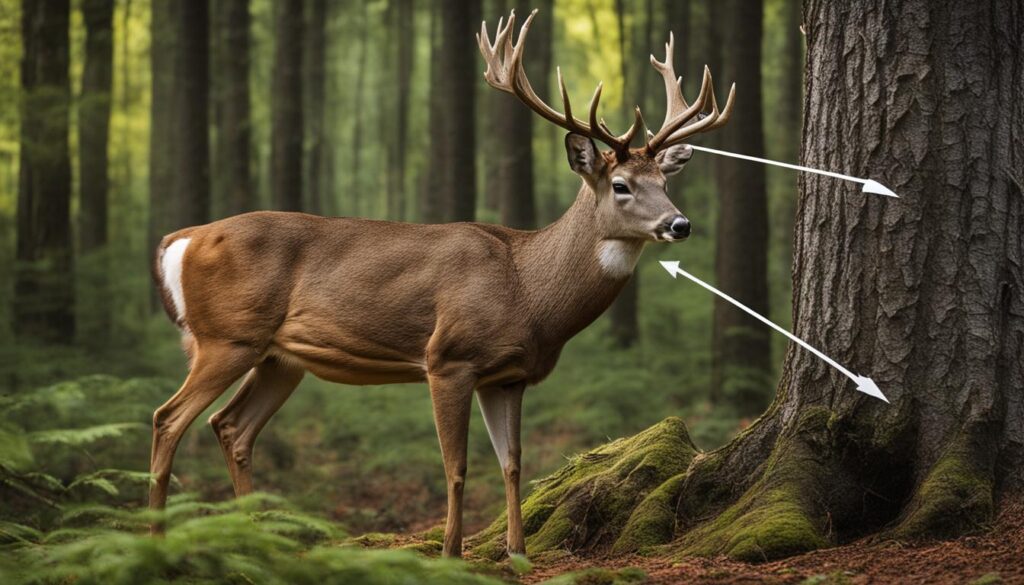
| Shot Angle | Advantages | Considerations |
|---|---|---|
| Broadside Shot | Perpendicular position offers a broad target area to hit vital organs. | Optimal shot placement with higher chances of quick and humane kills. |
| Quartering-Away Shot | Access to the heart and lungs, allowing for an ethical kill. | Requires aiming behind the shoulder to hit vital organs accurately. |
| Quartering-Towards Shot | Challenging angle that requires precision and experience. | Higher risk of hitting non-vital areas such as the shoulder and guts. |
Other Shot Placements and Considerations
While the broadside and quartering-away shots are the preferred choices, it’s important for hunters to be aware of other shot placements and the associated considerations. These alternative shots may come with higher risks or may not be recommended for various reasons. Let’s take a closer look at each one:
Frontal Shot
The frontal shot involves targeting the deer head-on. However, this shot presents a small target, making it challenging to hit the vital organs accurately. It also carries the potential risk of obstructing bone and fatty tissue, further reducing the chance of an effective kill. Due to the difficulty and the potential for wounding rather than killing the deer, the frontal shot is generally not recommended.
Head/Neck Shot
The head/neck shot involves aiming at the deer’s head or neck region. While it may seem like a precise shot, it comes with significant risks. A misplaced head/neck shot can result in poor shot placement, causing unnecessary suffering for the animal and potential damage to the meat. This shot is not advisable for ethical and effective deer hunting.
Straightaway Shot
The straightaway shot occurs when the deer is moving directly away from the hunter. While it may seem like an open opportunity for a shot, it can lead to poor shot placement and reduced chances of a clean kill. In addition, hitting the deer in the hindquarters may result in minimal damage and the risk of a wounded animal. Therefore, the straightaway shot is not the preferred choice for ethical hunting.
Straight-Down Shot
The straight-down shot is only available when hunting from treestands. It involves aiming at a deer directly below the hunter. This shot presents a small and challenging target, requiring exceptional accuracy. While it may seem tempting, the straight-down shot should be approached with caution. Misplaced shots can result in wounded animals and unnecessary suffering. Consider the difficulty and the potential risks carefully before attempting a straight-down shot.
Understanding these considerations and the associated risks can help hunters make ethical decisions in the field. By prioritizing precise shot placement and choosing the optimal angles, hunters can contribute to the successful and responsible harvest of deer.

Deer Shot Placement Tips and Factors to Consider
When preparing to take a shot at a deer, it’s important to consider various factors that can affect shot placement. One vital factor is the deer’s head position. A deer with its head down is more likely to react quickly and drop lower to the ground upon hearing the shot. This natural reaction can significantly impact the trajectory of your shot, potentially resulting in a missed or ineffective shot. It’s crucial for hunters to be aware of the deer’s head position and adjust their aim accordingly to compensate for any movement.
In addition to head position, another factor that hunters must account for is the potential for string jump. String jump occurs when a deer reacts to the sound of a shot by instinctively dropping its body to avoid the perceived threat. This reaction can cause the shot to impact higher on the deer’s body than intended, potentially resulting in a non-lethal or non-ideal shot. To compensate for string jump, hunters should aim slightly lower than the desired target, taking into consideration the deer’s reaction time.
Understanding these natural reactions and compensating for movement is essential in achieving precise shot placement. By carefully observing the deer’s head position and anticipating the potential for string jump, hunters can make the necessary adjustments to ensure a clean and ethical kill. A successful shot not only requires technical skill and accuracy but also a deep understanding of the animal’s behavior and natural instincts.

Remember, each hunting situation is unique, and it’s essential to assess the circumstances carefully. Taking the time to evaluate the deer’s head position, anticipate any potential reactions, and compensating for movement can significantly improve shot placement and increase the chances of a clean and ethical kill. By prioritizing precision and adapting to the deer’s behavior, hunters can contribute to responsible hunting practices and ensure humane harvests.
Conclusion
Mastering precise shot placement is the cornerstone of ethical hunting and ensuring a clean and humane kill. By understanding the anatomy of a deer and the vital organs involved, hunters can significantly increase their chances of success in the field while minimizing unnecessary suffering for the animal.
When aiming for a clean kill, hunters should prioritize targeting the heart and lungs. These vital organs provide the largest kill zone and offer a higher margin of error. By aiming for this area, hunters can achieve a quick and efficient takedown, leading to a clean harvest.
Remember, ethical hunting means making every shot count. By practicing precise shot placement and prioritizing clean kills, hunters can contribute to the responsible and sustainable management of deer populations. Let us embrace the importance of precision and ethical hunting practices for a more responsible future in the field.
